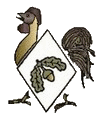Related Research Articles

The 30th Infantry Division was a United States Army unit of the National Guard that served in World War I and World War II. It was nicknamed the "Old Hickory" division, in honor of President Andrew Jackson. The Germans nicknamed this division "Roosevelt's SS". The 30th Infantry Division, involved in 282 days of intense combat over a period from June 1944 through April 1945, was regarded by a team of historians led by S.L.A. Marshall as the American infantry division that had "performed the most efficient and consistent battle services" in the European Theater of Operations (ETO). In the present day, the division's lineage continues as 30th Armored Brigade Combat Team, part of the North Carolina National Guard. The unit's most recent combat deployment was in 2019.
The 102nd Regiment of Foot was a regiment of the British Army raised by the Honourable East India Company in 1742. It transferred to the command of the British Army in 1862. Under the Childers Reforms it amalgamated with the 103rd Regiment of Foot in 1881 to form the Royal Dublin Fusiliers.

The 32nd Infantry Brigade Combat Team is an infantry brigade combat team (IBCT) in the United States Army National Guard. It was formed from the inactivated 32nd Infantry Division in 1967. It is the largest unit in the Wisconsin National Guard.
The 105th Regiment of Foot (Madras Light Infantry) was an infantry regiment of the British Army, raised by the Honourable East India Company in 1766. Under the Childers Reforms it amalgamated with the 51st (2nd Yorkshire West Riding) Regiment of Foot to form the King's Own Yorkshire Light Infantry.

The 40th Division was an infantry division of the British Army active during the First World War, where it served on the Western Front. It was a division of Lord Kitchener's New Army volunteers, mostly "bantam" recruits of below regulation height. It was later briefly reformed as a deception formation in the Second World War, and during the early years of the Cold War was recreated a third time to garrison Hong Kong.
The 65th Regiment of Foot was an infantry regiment of the British Army, raised in 1756 as the 2nd Battalion, 12th Regiment of Foot. Under the Childers Reforms it amalgamated with the 84th Regiment of Foot to become the 1st Battalion, York and Lancaster Regiment in 1881.

The 95th (Derbyshire) Regiment of Foot was a British Army infantry regiment, raised in 1823. Under the Childers Reforms, it amalgamated with the 45th (Nottinghamshire) Regiment of Foot to form the Sherwood Foresters in 1881.
The 41st (Welch) Regiment of Foot was an infantry regiment of the British Army, raised in 1719. Under the Childers Reforms it amalgamated with the 69th Regiment of Foot to form the Welch Regiment in 1881.
The 124th Regiment of Foot was an infantry regiment of the British Army, formed in 1794 and disbanded in 1795.
The 124th Regiment of Foot was an infantry regiment of the British Army, formed in 1762 and disbanded in 1763. Its colonel was Robert Cuninghame, 1st Baron Rossmore.
The 120th Regiment of Foot was an infantry regiment of the British Army, formed in 1763 by regimenting independent companies and disbanded in 1764. During its brief existence, Robert Dalrymple-Horn-Elphinstone was only the Colonel of the Regiment.
The 109th Regiment of Foot (Bombay Infantry) was an infantry regiment of the British Army from 1862 to 1881, when it was amalgamated into The Prince of Wales's Leinster Regiment (Royal Canadians).
The 112th Regiment of Foot was an infantry regiment of the British Army from 1794 to 1795. It was raised in July 1794 and stationed in Ireland.
The 112th Regiment of Foot (King's Royal Musqueteers) was an infantry regiment of the British Army from 1761 to 1763. It was raised in October 1761, taking its name from George III, and was disbanded in 1763.
The 111th Regiment of Foot was an infantry regiment of the British Army from 1761 to 1763 which was raised in 1761 by the regimentation of independent companies, and was disbanded in 1763.
The 107th Regiment of Foot was a short-lived infantry regiment of the British Army formed during the French Revolutionary Wars.
The 120th Infantry Regiment is an infantry regiment of the United States Army National Guard.

The 120th Guards Mechanised Brigade is a mechanised infantry brigade of the Belarus Ground Forces. It is the heir to the traditions of the Red Army 120th Guards Rifle Division which became the 120th Guards Motor Rifle Division in 1957.
The 120th Rifle Division was an infantry division of the Red Army, formed three times. Its first formation became the 6th Guards Rifle Division for its actions in the Yelnya Offensive. Its second formation became the 69th Guards Rifle Division for its actions in the Battle of Stalingrad. The division was reformed a third time in late April 1943. It was disbanded "in place" with the Central Group of Forces in the summer of 1945.
References
- ↑ "120th Regiment of Foot". regiments.org. Archived from the original on 28 January 2008.